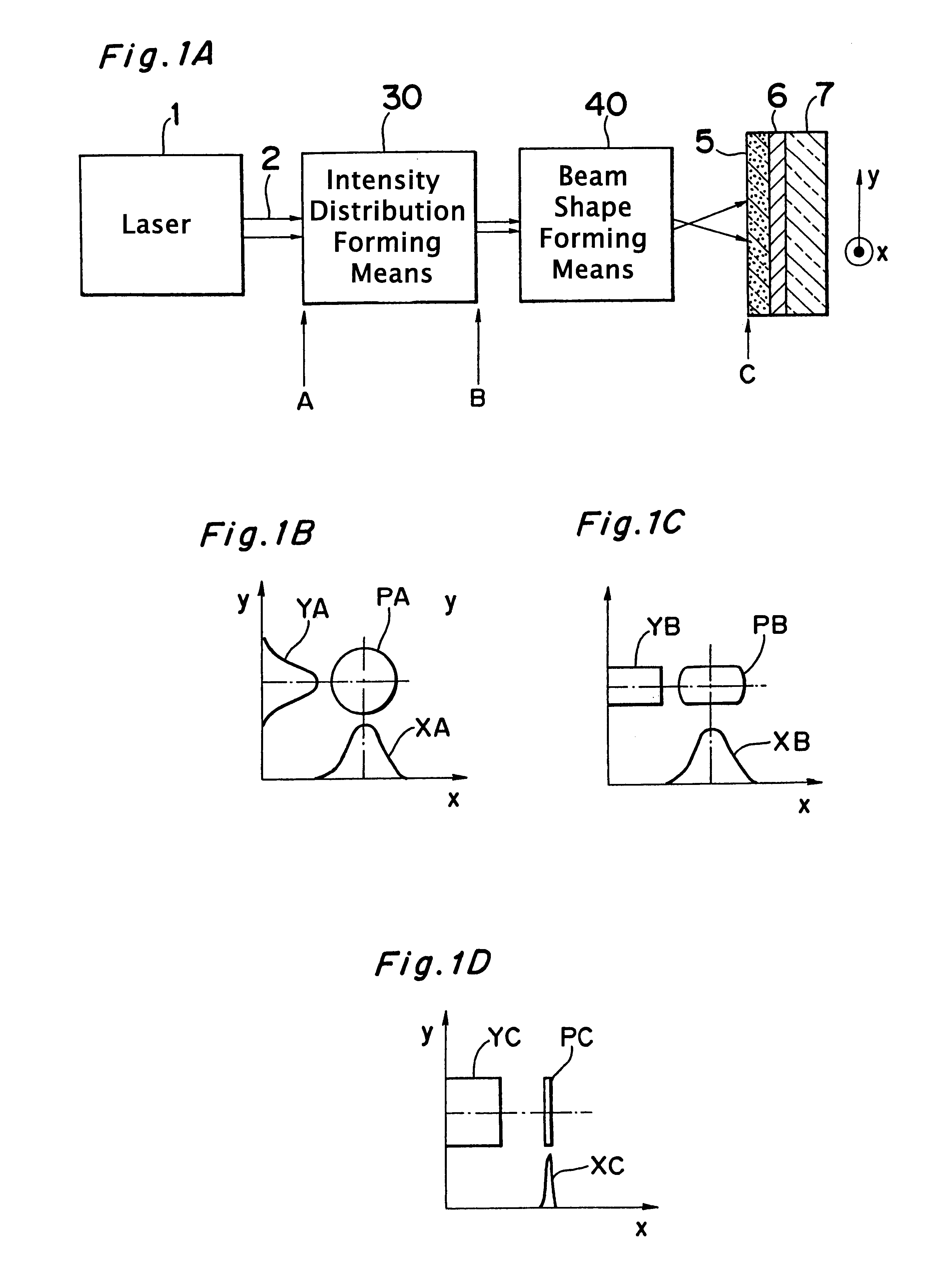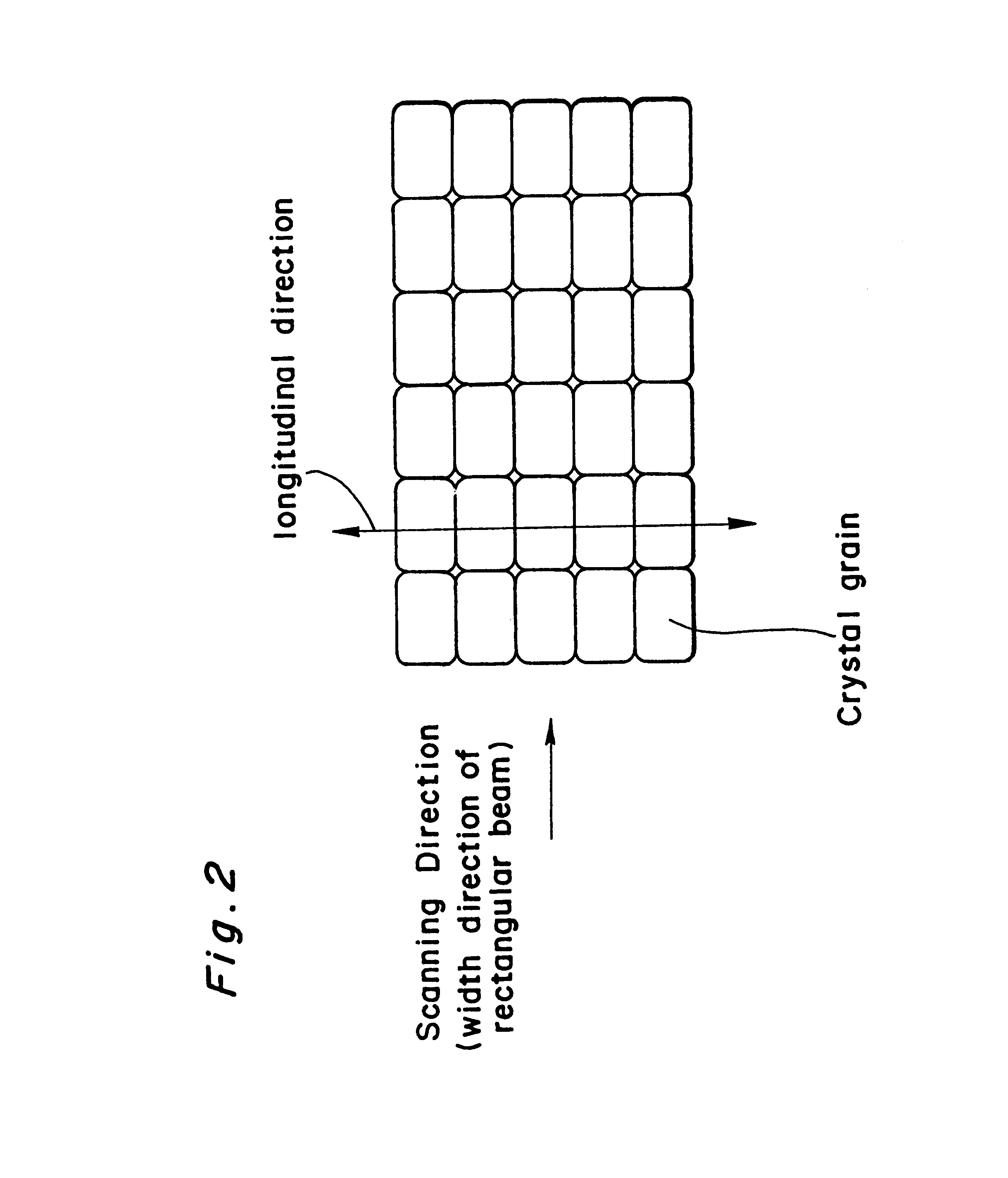Optical system and apparatus for laser heat treatment and method for producing semiconductor devices by using the same
a laser heat treatment and optical system technology, applied in laser beam welding apparatus, metal working apparatus, manufacturing tools, etc., can solve the problems of poor uniformity of polycrystalline silicon thin film, difficult to incorporate an integrated circuit having the required high-speed operation and high performance to the display panel, and poor performance of thin film transistors
- Summary
- Abstract
- Description
- Claims
- Application Information
AI Technical Summary
Benefits of technology
Problems solved by technology
Method used
Image
Examples
embodiment 1
FIGS. 3A and 3B show an optical system for laser heat treatment of an embodiment of the present invention, wherein an intensity distribution forming means 30 comprises a light transmitting element or waveguide that has totally reflecting planes. The intensity distribution forming means 30 may employ a light transmitting element with a pair of reflecting planes opposite to each other, for example, a wedge-shaped transparent element 31 made of a light transmitting material. Another light transmitting element or lightguide may use a pair of tapered or parallel mirrors opposed to each other with a distance slightly narrower than a diameter of the primary laser beam.
Description shows an example of using the wedge-shaped transparent element 31. The wedge-shaped element 31 is a tapered transparent block formed in the shape of a wedge, with the dimension in y direction decreasing toward the tip as shown in FIG. 3A, and the reflecting planes are separated at a distance slightly narrower than...
embodiment 2
In this embodiment shown in FIGS. 4A and 4B, the intensity distribution forming means employs a condenser lens 32 and a waveguide 33 consisting of a pair of reflecting planes disposed to oppose each other in front of the lens 32.
The waveguide 33 may comprise a light transmitting block having two totally reflecting planes opposed to each other, or a pair of mirrors opposed to each other.
For the condenser lens 32 which focuses the laser beam emitted by the oscillator into the waveguide 33, a spherical convex lens or a cylindrical convex lens may be used to converge or diverge in y direction the light into a waveguide.
An example of the intensity distribution forming means 30 is a combination of a spherical lens used as the lens 32 and a narrow light emitting block used as the waveguide 33. In this example, a pair of wide surfaces perpendicular to y direction of the block are used as totally reflecting planes.
The laser beam 2 emitted from the laser oscillator 1 is introduced by the conv...
embodiment 3
In another embodiment, the intensity distribution forming means 30 of the optical system for laser heat treatment comprises separated cylindrical lenses 34 that consist of two semi-cylindrical lenses, which are two halves obtained by dividing a single cylindrical lens at the center thereof, spaced from each other as shown in FIGS. 5A and 5B.
As shown in FIG. 5A, the separated cylindrical lenses 34 and 34 separated along y direction are disposed with the longitudinal direction thereof being disposed in x direction. The laser beam 2 emitted by the laser oscillator 1 is separated into a peripheral radiant fluxes refracted by the semi-cylindrical lenses and a middle radiant flux that passes straight between the two semi-cylindrical lenses. The separated radiant fluxes are combined with the middle radiant flux at the entrance of the beam shape forming means 40 to form a substantially uniform intensity distribution. In x direction, on the other hand, the laser beam 2 is output while mainta...
PUM
| Property | Measurement | Unit |
|---|---|---|
| wavelength | aaaaa | aaaaa |
| wavelength | aaaaa | aaaaa |
| wavelength | aaaaa | aaaaa |
Abstract
Description
Claims
Application Information
 Login to View More
Login to View More - R&D
- Intellectual Property
- Life Sciences
- Materials
- Tech Scout
- Unparalleled Data Quality
- Higher Quality Content
- 60% Fewer Hallucinations
Browse by: Latest US Patents, China's latest patents, Technical Efficacy Thesaurus, Application Domain, Technology Topic, Popular Technical Reports.
© 2025 PatSnap. All rights reserved.Legal|Privacy policy|Modern Slavery Act Transparency Statement|Sitemap|About US| Contact US: help@patsnap.com



